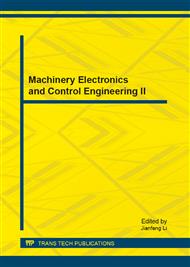[1]
Roundy, P. K. Wright, and J. Rabaey, "A study of low level vibrations as a power source for wireless sensor nodes", Computer Communications, vol. 26, 1131-1144, 2003.
DOI: 10.1016/s0140-3664(02)00248-7
Google Scholar
[2]
Amirtharajah, R., "Design of Low Power VLSI Systems Powered by Ambient Mechanical Vibration" Ph.D Thesis, Department of Electrical Engineering, Massachusetts Institute of Technology, June 1999.
Google Scholar
[3]
Chandrakasan, A., Amirtharajah, Goodman, R. J., Rabiner, W., "Trends in low power digital signal processing" Proceedings of the 1998 IEEE International Symposium on Circuits and Systems, 1998.
DOI: 10.1109/iscas.1998.699014
Google Scholar
[4]
Davis, W. R., Zhang, N., Camera, K., Chen, F., Markovic, D., Chan, N., Nikolic, B., Brodersen, R. W., "A design environment for high throughput, low power dedicated signal processing systems. Proceedings of the IEEE 2001 Custom Integrated Circuits Conference, 2001, pp.545-8.
DOI: 10.1109/cicc.2001.929839
Google Scholar
[5]
Amirtharajah, R., Meninger, S., Mur-Miranda, J. O., Chandrakasan, A. P., Lang, J., "A Micropower Programmable DSP Powered using a MEMS-based Vibration-to-Electric Energy Converter" IEEE International Solid State Circuits Conference, pp.362-363.
DOI: 10.1109/isscc.2000.839816
Google Scholar
[6]
S. Roundy, P. K. Wright and K. S. J. Pister, David A. Dornfeld "Energy Scavenging for Wireless Sensor Nodes with a Focus on Vibration to Electricity Conversion", A dissertation of Philosophy in Engineering-Mechanical Engineering in the UNIVERSITY OF CALIFORNIA, BERKELEY, Spring 2003.
Google Scholar
[7]
S. Meninger, "A Low Power Controller for a MEMS Based Energy Converter", Master of Science at the Massachusetts Institute of Technology, 1999.
Google Scholar
[8]
Scott Meninger, Jose Oscar Mur-Miranda, Rajeevan Amirtharajah, Anantha P. Chandrakasan, and Jeffrey H. Lang,, "Vibration-to-Electric Energy Conversion", IEEE TRANSACTIONS ON VERY LARGE SCALE INTEGRATION (VLSI) SYSTEMS, VOL. 9, NO. 1, FEBRUARY 2001.
DOI: 10.1109/92.920820
Google Scholar
[9]
Marwa S. Salem & Mona S. Salem, A. A. Zekry and H. F. Ragai, "Determining the Specifications of Controlling Pulses for Electrostatic MEMS Converter", 2006 International Conference on MEMS, NANO, and Smart Systems (ICMENS, 2006), 27 – 29 December 2006, Cairo, Egypt
DOI: 10.1109/icmens.2006.348210
Google Scholar
[10]
Marwa S. Salem Basyoni, A. A. Zekry, H. F. Ragai "Design of the Power Conditioning Circuit for Vibration Based Electrostatic MEMS Energy Converters Found in Energy Scavenging Systems" Advanced Material Research Journal, 2011.
DOI: 10.4028/www.scientific.net/amr.403-408.4551
Google Scholar


